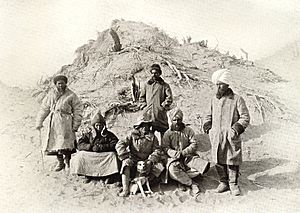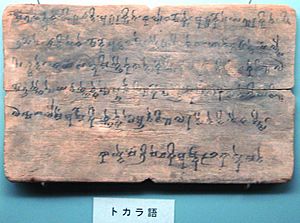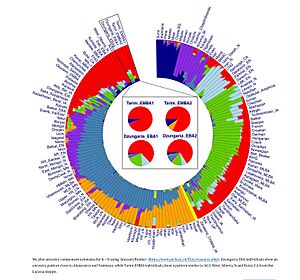Tarim mummies facts for kids
| Geographical range | Taklamakan Desert in the Tarim Basin |
|---|---|
| Period | Bronze Age |
| Dates | c. 2100 BCE - 1 BCE |
| Preceded by | Afanasievo culture |
| Followed by | Tocharians |
The Tarim mummies are very old preserved bodies found in the Tarim Basin in Xinjiang, China. These mummies date back to different times, from around 2100 BCE to 1 BCE. The earliest mummies belonged to people who lived around 2000 BCE. They were farmers and herders in an area that used to have freshwater but is now a desert.
A recent study in 2021 looked at the genes of these early mummies (from 2135 to 1623 BCE). It found that they had a lot of ancestry from an ancient group called Ancient North Eurasians (about 72%). They also had some ancestry from Ancient Northeast Asians (about 28%). However, they did not have genes from Western Steppe groups. This means they were a local group that stayed mostly separate. They learned farming and herding from their neighbors. This helped them live and grow in the Taklamakan Desert's changing river areas.
People once thought these mummies were ancestors of the Tocharians, who spoke an Indo-European language. But the genetic study showed no link to other Indo-European speaking groups like the Afanasievo culture or BMAC cultures. This suggests the mummies were not directly related to these groups.
Later Tarim Mummies from the Iron Age (around 1000 BCE) look similar to the Saka (Scythian) Pazyryk culture from the Altai Mountains. This is especially true for their weapons, horse gear, and clothes. These later mummies might be the ancestors of the Tocharians. The mummies found furthest east, at Qumul (from 1100-500 BCE), are the oldest Asian mummies in the Tarim Basin. They show a mix of people with "Europoid" (European-like) and "Mongoloid" (East Asian-like) features.
Contents
Discovering the Mummies

At the start of the 1900s, European explorers like Sven Hedin and Sir Aurel Stein found many dried-up bodies. They were searching for old items in Central Asia. Since then, many more mummies have been found and studied. Many are now in museums in Xinjiang. Most of these mummies were found in the eastern part of the Tarim Basin. Some were also found along the southern edge.
The earliest Tarim mummies were found at Qäwrighul. They date back to around 2135-1939 BCE. Studies of their skulls showed they were a "Proto-Europoid" type. They were most similar to Bronze Age people from southern Siberia and Kazakhstan. However, later studies found they were a unique group. They were different from European-related groups like the Andronovo culture or Afanasievo culture. They were also different from people in the BMAC culture. Later Tarim mummies showed different links. This suggests that various groups of people moved into the Tarim Basin over time.
Amazing Mummies and Their Clothes

Some famous mummies include the tall, red-haired "Cherchen Man" (1000 BCE). His son, a 1-year-old baby, had brown hair and two stones over his eyes. The "Hami Mummy" (around 1400–800 BCE) was a "red-headed beauty." The "Witches of Subeshi" (4th or 3rd century BCE) wore tall, black felt hats. Another man from Subeshi had signs of surgery on his stomach. The cut was sewn with horsehair.

Many mummies are in great condition. This is because the desert is very dry, which helped preserve them. The mummies have many features common to Caucasian people. Many have their hair still intact, from blond to red to dark brown. Their hair is often long, curly, and braided. Their clothes, especially the textiles, might show a shared origin with early European clothing styles. The Chärchän man wore a red twill tunic and tartan leggings. Experts found similarities between his tartan cloth and pieces from salt mines in Austria. Because of the dry conditions, tattoos have also been found on mummies from several sites.
The textiles found with the mummies seem to be an early European type. They are very similar to old cloth found in salt mines in Austria. These Austrian finds date back to the second millennium BCE. An expert on early textiles, Irene Good, noted that the woven diagonal twill pattern showed advanced weaving skills. She said it was the furthest east this weaving technique had been found.
The cemetery at Yanbulaq had 29 mummies from 1100 to 500 BCE. Twenty-one of them were Asian, the earliest Asian mummies found in the Tarim Basin. Eight others were of the same Caucasian type as those found at Qäwrighul.
Studying Their Genes
In 1995, a researcher named Victor Mair said that the earliest mummies in the Tarim Basin were "Caucasoid" (European-like). He believed that East Asian people arrived around 3,000 years ago. The Uyghur people arrived around 842 CE. Mair thought these early people might have come from the Pamir Mountains about 5,000 years ago.
Mair also said that new discoveries made old Chinese books seem more accurate. These books described historical figures as tall, with deep-set blue or green eyes, long noses, full beards, and red or blond hair. Scholars used to doubt these descriptions, but now they seem possible.
In 2007, the Chinese government allowed a National Geographic Society team to study the mummies' DNA. Scientists found that the Tarim Basin was lived in from 2000 BCE to 300 BCE. Early results suggested the people came from different places, including Europe, Mesopotamia, and the Indus Valley.
A 2008 study found that people from Yuansha were related to modern people in South Central Asia and the Indus Valley. They were also related to ancient people from Chawuhu.
Between 2009 and 2015, scientists studied the remains of 92 people from the Xiaohe Tomb complex. They looked at their Y-DNA (from fathers) and mtDNA (from mothers). The studies showed that the mothers' family lines came from both East Asia and West Eurasia. However, all the fathers' family lines came from West Eurasia. The East Eurasian mtDNA found in the mummies is common in people from southeast Siberia, like the Udeghe and Evenks.
Mitochondrial DNA analysis showed that the mothers' family lines included groups common in West Eurasia. These included haplogroups H, K, U5, U7, U2e, T, and R*. Groups common in East Asia were also found: B5, D, and G2a. Haplogroups common in Central Asian or Siberian people included C4 and C5. Some groups now common in South Asia, like M5 and M*, were also present.
A 2010 study found that almost all the males (11 out of 12) belonged to a Y-DNA group called R1a1-M17. This group is now most common in Northern India and Eastern Europe. The one other male belonged to a rare group called K* from Asia. The mixing of these groups likely happened in south Siberia.
Some people in China have used these findings to support ideas about separating regions. However, experts like Elizabeth Barber point out that the "Beauty of Loulan" is not closely related to modern Turkic or Han Chinese people. The features linked to Turks and Mongols appeared in the Tarim cemeteries much later. Because of concerns about fueling separatist movements, the Xinjiang museum displays all its mummies together, regardless of their age or origin.
Ancient North Eurasian Connection
A 2021 genetic study on 13 Tarim mummies (from 2135 to 1623 BCE) found something very interesting. They were most closely related to a very old group called the Ancient North Eurasians (ANE). Specifically, they were very similar to a person known as Afontova Gora 3 (AG3). About 72% of the Xiaohe mummies' ancestry came from AG3. The other 28% came from Ancient Northeast Asians (ANA) from the early Bronze Age Baikal region.
This means the Tarim mummies are one of the few groups from the Holocene period (the last 11,700 years) who get most of their genes from Ancient North Eurasians. This is true even though they lived much later than the main ANE groups. The study calls the Tarim mummies "the best representatives" of the Ancient North Eurasians.
Tests also showed that many groups in Central Asia and Xinjiang have some ancestry from a group related to the Tarim mummies. The Tajik people show the strongest link to the Tarim mummies. However, their main ancestry comes from Bronze Age Steppe herders.

Where Did They Come From?

Researchers Mallory and Mair (2000) suggested that at least two types of Caucasian people moved into the Tarim Basin. They linked these types to the Tocharian and Iranian language groups. However, professor Elizabeth Wayland Barber warns against assuming the mummies spoke Tocharian. She notes a gap of about a thousand years between the mummies and the known Tocharians. People can change their language without changing their genes.
On the other hand, linguistics professor Ronald Kim believes the Tocharian languages must have started about a thousand years before they were written down. This timing would match when the Tarim Basin culture was in the region.
Early studies of skull measurements questioned if the Tarim Basin people were European. They found the early population was a unique group. They had closer links to two bodies from the Harappan site in the Indus Valley. Later Tarim people were more similar to those from the Oxus River valley.
Han Kangxin studied the skulls of 302 mummies. He found the closest relatives of the early Tarim Basin people were from the Afanasevo culture. This culture was just north of the Tarim Basin. They were also related to the Andronovo culture in Kazakhstan and the Altai.
Mallory and Mair (2000) believe the earliest Bronze Age settlers of the Tarim and Turpan basins came from the Afanasevo culture. This culture (around 3500–2500 BCE) had cultural and genetic links to Indo-European groups. It existed before the Indo-Iranian Andronovo culture. This timing helps explain why Tocharian languages are different from Indo-Iranian languages.
Mair concluded that for the first 1,000 years after the "Beauty of Loulan" lived, only Caucasian people settled in the Tarim Basin. East Asian people only started appearing in the eastern parts of the Tarim Basin about 3,000 years ago. The Uighur peoples arrived after the fall of the Orkon Uighur Kingdom around 842 CE.
A 2004 study found no strong evidence that Steppe groups contributed much to the Tarim Basin people. They found that the early people from Qäwrighul were not closely related to the Afanasievo or Andronovo cultures. They also found that later people from Alwighul and Krorän were not from Steppe groups. Instead, they were more similar to people from the Eastern Mediterranean region.
A 2021 study suggested that the "Western" features of the early Tarim mummies came from their Ancient North Eurasian ancestry. Earlier skull studies found they were a unique group. They did not group with European-related Steppe herders, Western Asian BMAC people, or East Asian populations.

Ancient Records and Languages
Chinese Records
The "Western Regions" (Xīyù) was the Chinese name for areas west of Yumen Pass. This included the Tarim and Central Asia, from the 3rd century BCE to the 8th century CE.
Chinese records described some people in the Western Regions as having full beards, red or blond hair, deep-set blue or green eyes, and high noses. The city-states of the Tarim were most powerful around the 3rd to 4th centuries CE. This might also mean that China became more involved in the Tarim after the Kushan Empire fell.
The Rouzhi People
The Rouzhi people might have been mentioned around the 7th century BCE by the Chinese philosopher Guan Zhong. His book describes a group called Yuzhi or Niuzhi. They were from the north-west and supplied jade to the Chinese from nearby mountains.
After the Rouzhi were defeated by the Xiongnu in the 2nd century BCE, a group called the Greater Rouzhi moved to Bactria. There, they started the Kushan Empire. By the 1st Century CE, the Kushan Empire had grown a lot. It might have taken over parts of the Tarim Basin.
Tocharian Languages

Modern scholars know about Tocharian A and Tocharian B languages. There's also a less known Tocharian C. These languages were very different from each other. This suggests that a common, early Tocharian language existed in the Tarim during the second half of the 1st Millennium BCE. Tocharian is found in documents from the 3rd to 9th centuries CE. The earliest known writing is from the 6th century CE.
The Tarim mummies lived about 2,000 years before the Tocharian texts. But because they were found in the same area and had links to Western Eurasia, many scholars thought the mummies were related to the Tocharian peoples.
Ideas About Cultural Exchange
If Indo-European language speakers were in the Tarim Basin around 2000 BCE, it could mean cultures exchanged ideas very early. For example, techniques like chariot warfare and bronze-making might have been brought to China by these Indo-European nomads. Mallory and Mair also note that before 2000 BC, very few metal items were found in China. The ones found were already made of alloyed copper, which is puzzling.
Experts are still debating whether bronze technology traveled from China to the West or vice versa. However, the evidence so far suggests that early bronze technology in China was influenced by contact with western steppe cultures. But the culture and technology in the Tarim basin were less advanced than in East China. The earliest bronze use in China was in the Yellow River region (like the Erlitou culture from 2070 BCE). This suggests the northwest region didn't use metal until bronze came from the Shang dynasty around 1600 BC.
The earliest bronze items in China are from the Majiayao culture (3100 and 2700 BCE). From there, the Chinese Bronze Age spread. The US National Gallery of Art says the Chinese Bronze Age was from about 2000 BC to 771 BC. This period starts with Erlitou culture. Since this was much later than bronze was found in Mesopotamia, bronze technology could have been brought to China. However, some believe bronze work developed in China on its own.
The Chinese official Zhang Qian visited Bactria and Sogdiana in 126 BCE. He made the first Chinese report on many regions west of China. He thought he saw Greek influences in some kingdoms. He called Parthia "Ānxī," which came from "Arshak," the founder of the Parthian dynasty. Zhang Qian described Parthia as an advanced city-based civilization. They farmed grain and grapes and made silver coins and leather goods. He thought Parthia was as advanced as Dayuan in Ferghana and Daxia in Bactria.
The trade of Tarim Basin jade to China from ancient times is well known. Ancient Chinese rulers loved jade. Over 750 jade items found in the Tomb of Fu Hao from the Shang dynasty came from Khotan in modern Xinjiang. As early as the mid-first millennium BCE, the Yuezhi people were involved in the jade trade. The main buyers were the rulers of agricultural China.
Famous Mummies
The Princess of Xiaohe
The Princess of Xiaohe was found in 2003 by archaeologists in Xinjiang. She was found at Xiaohe Cemetery Tomb M11, west of Loulan. She has red hair and long eyelashes. She was wrapped in a white wool cloak and wore a felt hat, a string skirt, and fur-lined leather boots. She was buried with wooden pins and small bags of ephedra plants. Twigs and branches of ephedra were placed next to her body. She is not always on display in a museum.
The Beauty of Loulan
The Beauty of Loulan is one of the most famous Tarim mummies. She was found in 1980 by Chinese archaeologists making a film about the Silk Road. The mummy was found near Lop Nur, buried 3 feet deep. She was very well preserved because of the dry climate and the salt. She was wrapped in a woolen cloth that didn't cover her ankles. She was surrounded by gifts for the afterlife. The Beauty of Loulan dates back to around 1800 BCE.
The Beauty of Loulan lived around 1800 BCE and died at about 45 years old. She likely died from lung problems caused by breathing in a lot of sand, charcoal, and dust. According to Elizabeth Barber, she probably died in winter because of her warm clothes. Her rough clothes and lice in her hair suggest she lived a hard life.
The Beauty of Loulan's hair is described as auburn. Her hair had lice. She wore clothes made of wool and fur. Her hood was made of felt and had a feather. She wore rough, ankle-high moccasins made of leather with fur outside. Her skirt was leather with fur inside for warmth. She also wore a woolen cap. These warm clothes suggest she died in winter. The Beauty of Loulan had a comb with four teeth. Barber thinks it was also used to pack threads tightly when weaving. She also had a "neatly woven bag or soft basket" with wheat grains inside.
Yingpan Man
The Yingpan man is a much later mummy from the same area. He dates to the 4th–5th century CE. He was dressed in fancy Hellenistic clothes. He might have been a Sogdian or an important person from the Shanshan Kingdom.
Images for kids
-
Another "Loulan Beauty", excavated in 2004. Buried at the age of 25, she is 3800 years old
See also
- Pazyryk culture
- Pontic–Caspian steppe
- Dzungarian Gate
- Gushi culture
- Tocharian clothing
- Kurgan hypothesis






